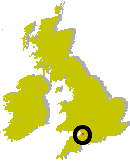Inquest & Trial
The inquest at Axbridge magistrates’ court took two and half-hours and six witnesses were called. Mr. Peter Tiarks was the first to be called and after describing what had happened was asked if Miss O’Connor benefited from Miss Bul’s will. He said that he knew she did not and on being cross-examined further stated that as far as he was aware there was no motive for the alleged crime. Mrs. Eva Simmons identified underwear and a striped dress belonging to the accused, and thought that the accused would be very upset if anything untoward had happened to Miss. Buls. Dr. Cooper said that he had known both Miss O’Connor and Miss Buls for a number of years and that he had always found the accused level-headed, competent and willing to help people.
Police Sergeant C. Woodriffe said that he had searched the bedroom found a tooth, some hair and a broken comb. He also examined the bathroom and found a brassiere, underslip and striped dress, which were all wet at the top. He found a towel that appeared to be bloodstained. All these items and a phial of scrapings from Miss O’Connor’s nails were taken to the Forensic Science Laboratory.
The pathologist gave his report and reported that he had found loose hair clutched in the right hand of the deceased and that one hand was swollen and covered in blood. The eyes had been ruptured and in his opinion, death was due to shock following violent injuries to the face and eyes. He stated that it was possible that the tooth found on the floor was loose in its socket and was removed after death.
Inspector Long stated that after Miss O’Connor was detained at Weston super Mare she was quiet until the evening when she began repeating religious expressions, started moving furniture about and knelt down to pray. She became very violent and a doctor was called and she was removed to the cells where she shouted out prayers and religious phrases for several hours until about 10 p.m. when she became exhausted. The next day she showed more signs of mental aberration during the journey to Exeter Prison.
At the end of the hearing the charge was read to Miss O’Connor and she pleaded not guilty and reserved her defence. She was sent for trail at Somerset Assize, Wells on October 15th, 1954. The hearing took two and quarter hours and Miss O’Connor sat impassively in the dock and rarely raised her eyes.
The first witness called by the defence was Mr. Maurice William Bailey, a former clerk of Axbridge Rural District Council and a director of the Callow Rock Lime Co. He told the court that he had known Miss O’Connor, also a director for about six years. When she went into his office on August 31st they discussed a business trip that she had made to Plymouth. She told Mr. Bailey that she had had lunch and sat at the same table as she had sat with the late Mr. Frank Tiarks and said that Mr. Tiarks was helping and guiding her. There was further discussion about the car journey to Plymouth when Miss O’Connor spoke about an escape from sudden death after a near collision, which she blamed on another passenger. Mr Bailey was asked by the defending counsel, Mr. Norman Skelhorn, Q.C., what he thought her state of mind was. Mr. Bailey asserted that he thought that she was mentally deranged.
The second witness was Dr. Thomas Christie, medical officer at Holloway Prison who said that since her transfer to the prison on September 25th she had been kept under observation. He told the court that in his opinion Miss O’Connor was suffering from acute mania, a recognised disease of the mind. This condition meant that she would be incapable of knowing that what she was doing was wrong. The third witness Dr. Desmond Curran, Psychiatrist at St. George’s Hospital; London had two long interviews with Miss O’Connor and agreed with Dr. Christie that it was very dubious whether she knew what she was doing.
The defence witnesses were not cross-examined by the prosecution and Miss O’Connor was not called to the witness box. Mr. Skelhorn then addressed the jury of ten men and two women. They were told that there was no motive to the crime because the two women had always been on friendly terms and that Miss O’Connor had nothing to gain from the death of Miss Buls. [Image: Noreen O’Connor presenting Prizes]Everyone knew that Miss O’Connor was a kind friendly person. The injuries to Miss Buls were probably inflicted when she was unconscious and that she did not suffer. He pointed out that Miss O’Connor did not know what she was doing because she was suffering from a deep defect of reasoning. Mr. Skelhorn suggested to the jury that they were entitled to find a special verdict.
In his summing up the judge, Mr. Justice Byrne advised the jury that if they were satisfied with the evidence they would not have any doubt that Miss O’Connor was guilty of the murder of Miss Buls. However, he asked them to consider the second aspect of the case that the accused did not know what she was doing, or if she did know then she did not know it was wrong. If they thought she was guilty then he advised them that the proper verdict would be ‘Guilty but insane’.
The jury did not retire and took a minute to decide their verdict of ‘Guilty but insane’ and the judge ordered Miss O’Connor to be detained as a Broadmoor patient until her majesty’s pleasure be known. After her release she visited Loxton and had regained her normal pleasant personality. She spent the rest of her life in St Andrews Hospital in Northampton and died in 1983.
